Deck 2: Derivatives
سؤال
سؤال
سؤال
سؤال
سؤال
سؤال
سؤال
سؤال
سؤال
سؤال
سؤال
سؤال
سؤال
سؤال
سؤال
سؤال
سؤال
سؤال
سؤال
سؤال
سؤال
سؤال
سؤال
سؤال
سؤال
سؤال
سؤال
سؤال
سؤال
سؤال
سؤال
سؤال
سؤال
سؤال
سؤال
سؤال
سؤال
سؤال
سؤال
سؤال
سؤال
سؤال
سؤال
سؤال
سؤال
سؤال
سؤال
سؤال
سؤال
سؤال
سؤال
سؤال
سؤال
سؤال
سؤال
سؤال
سؤال
سؤال
سؤال
سؤال
سؤال
سؤال
سؤال
سؤال
سؤال
سؤال
سؤال
سؤال
سؤال
سؤال
سؤال
سؤال
سؤال
سؤال
سؤال
سؤال
سؤال
سؤال
سؤال
سؤال

فتح الحزمة
قم بالتسجيل لفتح البطاقات في هذه المجموعة!
Unlock Deck
Unlock Deck
1/151
العب
ملء الشاشة (f)
Deck 2: Derivatives
1
Find the linearization of a suitable function, and then use it to approximate the number.
sin 0.3
sin 0.3

2
A point moves along the curve  . When the point is at
. When the point is at  , its x-coordinate is increasing at the rate of 3 units per second. How fast is its y-coordinate changing at that instant of time?
, its x-coordinate is increasing at the rate of 3 units per second. How fast is its y-coordinate changing at that instant of time?
A) units/sec
units/sec
B) units/sec
units/sec
C) units/sec
units/sec
D) units/sec
units/sec
 . When the point is at
. When the point is at  , its x-coordinate is increasing at the rate of 3 units per second. How fast is its y-coordinate changing at that instant of time?
, its x-coordinate is increasing at the rate of 3 units per second. How fast is its y-coordinate changing at that instant of time?A)
 units/sec
units/secB)
 units/sec
units/secC)
 units/sec
units/secD)
 units/sec
units/sec units/sec
units/sec 3
Use the linear approximation of the function  at
at  to approximate the number
to approximate the number  .
.
A)
B)
C)
D)
E)
 at
at  to approximate the number
to approximate the number  .
.A)

B)

C)

D)

E)


4
Find the differential of the function. 


فتح الحزمة
افتح القفل للوصول البطاقات البالغ عددها 151 في هذه المجموعة.
فتح الحزمة
k this deck
5
Two cars start moving from the same point. One travels south at  mi/h and the other travels west at
mi/h and the other travels west at  mi/h. At what rate is the distance between the cars increasing 2 hours later? Round the result to the nearest hundredth.
mi/h. At what rate is the distance between the cars increasing 2 hours later? Round the result to the nearest hundredth.
A)
B)
C)
D)
E)
 mi/h and the other travels west at
mi/h and the other travels west at  mi/h. At what rate is the distance between the cars increasing 2 hours later? Round the result to the nearest hundredth.
mi/h. At what rate is the distance between the cars increasing 2 hours later? Round the result to the nearest hundredth.A)

B)

C)

D)

E)


فتح الحزمة
افتح القفل للوصول البطاقات البالغ عددها 151 في هذه المجموعة.
فتح الحزمة
k this deck
6
The circumference of a sphere was measured to be  cm with a possible error of
cm with a possible error of  cm. Use differentials to estimate the maximum error in the calculated volume.
cm. Use differentials to estimate the maximum error in the calculated volume.
 cm with a possible error of
cm with a possible error of  cm. Use differentials to estimate the maximum error in the calculated volume.
cm. Use differentials to estimate the maximum error in the calculated volume.
فتح الحزمة
افتح القفل للوصول البطاقات البالغ عددها 151 في هذه المجموعة.
فتح الحزمة
k this deck
7
Find the linearization L (x) of the function at
a.
A) x -
x - 
B) x +
x + 
C) x -
x - 
D) x +
x + 
a.

A)
 x -
x - 
B)
 x +
x + 
C)
 x -
x - 
D)
 x +
x + 

فتح الحزمة
افتح القفل للوصول البطاقات البالغ عددها 151 في هذه المجموعة.
فتح الحزمة
k this deck
8
The top of a ladder slides down a vertical wall at a rate of  m/s . At the moment when the bottom of the ladder is 3 m from the wall, it slides away from the wall at a rate of 0.2 m/s . How long is the ladder?
m/s . At the moment when the bottom of the ladder is 3 m from the wall, it slides away from the wall at a rate of 0.2 m/s . How long is the ladder?
A)
B)
C)
D)
E)None of these
 m/s . At the moment when the bottom of the ladder is 3 m from the wall, it slides away from the wall at a rate of 0.2 m/s . How long is the ladder?
m/s . At the moment when the bottom of the ladder is 3 m from the wall, it slides away from the wall at a rate of 0.2 m/s . How long is the ladder?A)

B)

C)

D)

E)None of these

فتح الحزمة
افتح القفل للوصول البطاقات البالغ عددها 151 في هذه المجموعة.
فتح الحزمة
k this deck
9
Two sides of a triangle are  m and
m and  m in length and the angle between them is increasing at a rate of
m in length and the angle between them is increasing at a rate of  rad/s. Find the rate at which the area of the triangle is increasing when the angle between the sides of fixed length is /3 .
rad/s. Find the rate at which the area of the triangle is increasing when the angle between the sides of fixed length is /3 .
A)
B)
C)
D)
E)
 m and
m and  m in length and the angle between them is increasing at a rate of
m in length and the angle between them is increasing at a rate of  rad/s. Find the rate at which the area of the triangle is increasing when the angle between the sides of fixed length is /3 .
rad/s. Find the rate at which the area of the triangle is increasing when the angle between the sides of fixed length is /3 .A)

B)

C)

D)

E)


فتح الحزمة
افتح القفل للوصول البطاقات البالغ عددها 151 في هذه المجموعة.
فتح الحزمة
k this deck
10
Use differentials to estimate the amount of paint needed to apply a coat of paint  cm thick to a hemispherical dome with diameter
cm thick to a hemispherical dome with diameter  m.
m.
A)
B)
C)
D)
E)
 cm thick to a hemispherical dome with diameter
cm thick to a hemispherical dome with diameter  m.
m.A)

B)

C)

D)

E)


فتح الحزمة
افتح القفل للوصول البطاقات البالغ عددها 151 في هذه المجموعة.
فتح الحزمة
k this deck
11
Find the differential of the function at the indicated number. 
A) dx
dx
B) dx
dx
C) dx
dx
D) dx
dx

A)
 dx
dxB)
 dx
dxC)
 dx
dxD)
 dx
dx
فتح الحزمة
افتح القفل للوصول البطاقات البالغ عددها 151 في هذه المجموعة.
فتح الحزمة
k this deck
12
If two resistors with resistances  and
and  are connected in parallel, as in the figure, then the total resistance
are connected in parallel, as in the figure, then the total resistance  measured in ohms ( ), is given by
measured in ohms ( ), is given by  . If
. If  and
and  are increasing at rates of
are increasing at rates of  and
and  respectively, how fast is
respectively, how fast is  changing when
changing when  and
and  ?
?
Round the result to the nearest thousandth.
A)
B)
C)
D)
E)
 and
and  are connected in parallel, as in the figure, then the total resistance
are connected in parallel, as in the figure, then the total resistance  measured in ohms ( ), is given by
measured in ohms ( ), is given by  . If
. If  and
and  are increasing at rates of
are increasing at rates of  and
and  respectively, how fast is
respectively, how fast is  changing when
changing when  and
and  ?
?Round the result to the nearest thousandth.

A)

B)

C)

D)

E)


فتح الحزمة
افتح القفل للوصول البطاقات البالغ عددها 151 في هذه المجموعة.
فتح الحزمة
k this deck
13
Compute  and dy for the given values of x and
and dy for the given values of x and  .
. 
A)
B)
C)
D)
E)
 and dy for the given values of x and
and dy for the given values of x and  .
. 
A)

B)

C)

D)

E)


فتح الحزمة
افتح القفل للوصول البطاقات البالغ عددها 151 في هذه المجموعة.
فتح الحزمة
k this deck
14
Let y = 1/x.
a.Find x and y if x changes from 1 to 1.03.Round to six decimal places, if necessary.
b.Find the differential dy, and use it to approximate y if x changes from 1 to 1.03.
c.Compute y - dy, the error in approximating y by dy.
a.Find x and y if x changes from 1 to 1.03.Round to six decimal places, if necessary.
b.Find the differential dy, and use it to approximate y if x changes from 1 to 1.03.
c.Compute y - dy, the error in approximating y by dy.

فتح الحزمة
افتح القفل للوصول البطاقات البالغ عددها 151 في هذه المجموعة.
فتح الحزمة
k this deck
15
Determine the values of x for which the given linear approximation is accurate to within 0.07 at a = 0. 
A)
B)
C)
D)
E)

A)

B)

C)

D)

E)


فتح الحزمة
افتح القفل للوصول البطاقات البالغ عددها 151 في هذه المجموعة.
فتح الحزمة
k this deck
16
A plane flying horizontally at an altitude of 1 mi and a speed of  mi/h passes directly over a radar station. Find the rate at which the distance from the plane to the station is increasing when it is 2 mi away from the station.
mi/h passes directly over a radar station. Find the rate at which the distance from the plane to the station is increasing when it is 2 mi away from the station.
A)
B)
C)
D)
E)
 mi/h passes directly over a radar station. Find the rate at which the distance from the plane to the station is increasing when it is 2 mi away from the station.
mi/h passes directly over a radar station. Find the rate at which the distance from the plane to the station is increasing when it is 2 mi away from the station.A)

B)

C)

D)

E)


فتح الحزمة
افتح القفل للوصول البطاقات البالغ عددها 151 في هذه المجموعة.
فتح الحزمة
k this deck
17
Find the differential of the function at the indicated number. 
A) dx
dx
B) dx
dx
C) dx
dx
D) dx
dx

A)
 dx
dxB)
 dx
dxC)
 dx
dxD)
 dx
dx
فتح الحزمة
افتح القفل للوصول البطاقات البالغ عددها 151 في هذه المجموعة.
فتح الحزمة
k this deck
18
An equation relating the variables x and y, the values of x and y, and the value of  at a particular instant of time are given. Find the value of
at a particular instant of time are given. Find the value of  .
. 
A)
B)
C)
D)
 at a particular instant of time are given. Find the value of
at a particular instant of time are given. Find the value of  .
. 
A)

B)

C)

D)


فتح الحزمة
افتح القفل للوصول البطاقات البالغ عددها 151 في هذه المجموعة.
فتح الحزمة
k this deck
19
Gravel is being dumped from a conveyor belt at a rate of  ft /min and its coarseness is such that it forms a pile in the shape of a cone whose base diameter and height are always equal. How fast is the height of the pile increasing when the pile is
ft /min and its coarseness is such that it forms a pile in the shape of a cone whose base diameter and height are always equal. How fast is the height of the pile increasing when the pile is  ft high? Round the result to the nearest hundredth.
ft high? Round the result to the nearest hundredth. 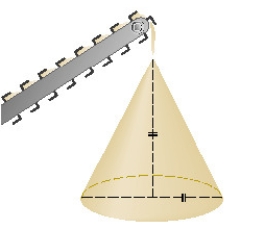
A)
B)
C)
D)
E)
 ft /min and its coarseness is such that it forms a pile in the shape of a cone whose base diameter and height are always equal. How fast is the height of the pile increasing when the pile is
ft /min and its coarseness is such that it forms a pile in the shape of a cone whose base diameter and height are always equal. How fast is the height of the pile increasing when the pile is  ft high? Round the result to the nearest hundredth.
ft high? Round the result to the nearest hundredth. 
A)

B)

C)

D)

E)


فتح الحزمة
افتح القفل للوصول البطاقات البالغ عددها 151 في هذه المجموعة.
فتح الحزمة
k this deck
20
A car leaves an intersection traveling west. Its position 4 sec later is 26 ft from the intersection. At the same time, another car leaves the same intersection heading north so that its position 4 sec later is 26 ft from the intersection. If the speeds of the cars at that instant of time are 12 ft/sec and 10 ft/sec, respectively, find the rate at which the distance between the two cars is changing. Round to the nearest tenth if necessary.
A)15.6 ft/sec
B)3.7 ft/sec
C)3.1 ft/sec
D)36.8 ft/sec
A)15.6 ft/sec
B)3.7 ft/sec
C)3.1 ft/sec
D)36.8 ft/sec

فتح الحزمة
افتح القفل للوصول البطاقات البالغ عددها 151 في هذه المجموعة.
فتح الحزمة
k this deck
21
The quantity Q of charge in coulombs C that has passed through a point in a wire up to time t (measured in seconds) is given by  . Find the current when
. Find the current when  .
.
A)
B)
C)
D)
E)
 . Find the current when
. Find the current when  .
.A)

B)

C)

D)

E)


فتح الحزمة
افتح القفل للوصول البطاقات البالغ عددها 151 في هذه المجموعة.
فتح الحزمة
k this deck
22
A water trough is 20 m long and a cross-section has the shape of an isosceles trapezoid that is 20 cm wide at the bottom, 60 cm wide at the top, and has height 50 cm. If the trough is being filled with water at the rate of  , how fast is the water level rising when the water is
, how fast is the water level rising when the water is  cm deep? Round the result to the nearest hundredth.
cm deep? Round the result to the nearest hundredth.
 , how fast is the water level rising when the water is
, how fast is the water level rising when the water is  cm deep? Round the result to the nearest hundredth.
cm deep? Round the result to the nearest hundredth.
فتح الحزمة
افتح القفل للوصول البطاقات البالغ عددها 151 في هذه المجموعة.
فتح الحزمة
k this deck
23
The sides of a square baseball diamond are 90 ft long. When a player who is between the second and third base is 30 ft from second base and heading toward third base at a speed of 24 ft/sec, how fast is the distance between the player and home plate changing? Round to two decimal places. 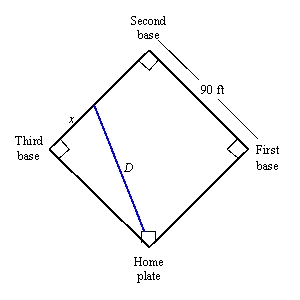


فتح الحزمة
افتح القفل للوصول البطاقات البالغ عددها 151 في هذه المجموعة.
فتح الحزمة
k this deck
24
If a snowball melts so that its surface area decreases at a rate of  , find the rate at which the diameter decreases when the diameter is
, find the rate at which the diameter decreases when the diameter is  cm.
cm.
 , find the rate at which the diameter decreases when the diameter is
, find the rate at which the diameter decreases when the diameter is  cm.
cm.
فتح الحزمة
افتح القفل للوصول البطاقات البالغ عددها 151 في هذه المجموعة.
فتح الحزمة
k this deck
25
The volume of a right circular cone of radius r and height h is  . Suppose that the radius and height of the cone are changing with respect to time t.
. Suppose that the radius and height of the cone are changing with respect to time t.
a.Find a relationship between ,
,  , and
, and  .
.
b.At a certain instant of time, the radius and height of the cone are 12 in.and 13 in.and are increasing at the rate of 0.2 in./sec and 0.5 in./sec, respectively.How fast is the volume of the cone increasing?
 . Suppose that the radius and height of the cone are changing with respect to time t.
. Suppose that the radius and height of the cone are changing with respect to time t. a.Find a relationship between
 ,
,  , and
, and  .
. b.At a certain instant of time, the radius and height of the cone are 12 in.and 13 in.and are increasing at the rate of 0.2 in./sec and 0.5 in./sec, respectively.How fast is the volume of the cone increasing?

فتح الحزمة
افتح القفل للوصول البطاقات البالغ عددها 151 في هذه المجموعة.
فتح الحزمة
k this deck
26
A boat is pulled into a dock by a rope attached to the bow of the boat and passing through a pulley on the dock that is 1 m higher than the bow of the boat. If the rope is pulled in at a rate of 2 m/s how fast is the boat approaching the dock when it is 3 m from the dock? Round the result to the nearest hundredth if necessary. 


فتح الحزمة
افتح القفل للوصول البطاقات البالغ عددها 151 في هذه المجموعة.
فتح الحزمة
k this deck
27
In calm waters, the oil spilling from the ruptured hull of a grounded tanker spreads in all directions. Assuming that the polluted area is circular, determine how fast the area is increasing when the radius of the circle is 20 ft and is increasing at the rate of  ft/sec. Round to the nearest tenth if necessary.
ft/sec. Round to the nearest tenth if necessary.
 ft/sec. Round to the nearest tenth if necessary.
ft/sec. Round to the nearest tenth if necessary.
فتح الحزمة
افتح القفل للوصول البطاقات البالغ عددها 151 في هذه المجموعة.
فتح الحزمة
k this deck
28
Two carts, A and B, are connected by a rope 39 ft long that passes over a pulley (see the figure below). The point Q is on the floor 12 ft directly beneath and between the carts. Cart A is being pulled away from Q at a speed of  ft/s. How fast is cart B moving toward Q at the instant when cart A is 5 ft from Q?
ft/s. How fast is cart B moving toward Q at the instant when cart A is 5 ft from Q? 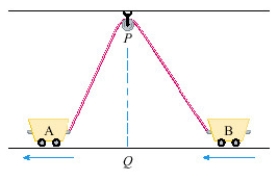
 ft/s. How fast is cart B moving toward Q at the instant when cart A is 5 ft from Q?
ft/s. How fast is cart B moving toward Q at the instant when cart A is 5 ft from Q? 

فتح الحزمة
افتح القفل للوصول البطاقات البالغ عددها 151 في هذه المجموعة.
فتح الحزمة
k this deck
29
Find the instantaneous rate of change of the function  when
when 
A)
B)3
C)9
D)
 when
when 
A)

B)3
C)9
D)


فتح الحزمة
افتح القفل للوصول البطاقات البالغ عددها 151 في هذه المجموعة.
فتح الحزمة
k this deck
30
The top of a ladder slides down a vertical wall at a rate of 0.15 m/s . At the moment when the bottom of the ladder is 1.5 m from the wall, it slides away from the wall at a rate of 0.3 m/s. How long is the ladder?
A)3.9 m
B)3.4 m
C)4.4 m
D)2.9 m
E)2.4 m
A)3.9 m
B)3.4 m
C)4.4 m
D)2.9 m
E)2.4 m

فتح الحزمة
افتح القفل للوصول البطاقات البالغ عددها 151 في هذه المجموعة.
فتح الحزمة
k this deck
31
A water trough is 20 m long and a cross-section has the shape of an isosceles trapezoid that is 20 cm wide at the bottom, 60 cm wide at the top, and has height 50 cm. If the trough is being filled with water at the rate of  , how fast is the water level rising when the water is
, how fast is the water level rising when the water is  cm deep? Round the result to the nearest hundredth.
cm deep? Round the result to the nearest hundredth.
 , how fast is the water level rising when the water is
, how fast is the water level rising when the water is  cm deep? Round the result to the nearest hundredth.
cm deep? Round the result to the nearest hundredth.
فتح الحزمة
افتح القفل للوصول البطاقات البالغ عددها 151 في هذه المجموعة.
فتح الحزمة
k this deck
32
The height (in meters) of a projectile shot vertically upward from a point  m above ground level with an initial velocity of 25.48 m/s is
m above ground level with an initial velocity of 25.48 m/s is  after t seconds. a) When does the projectile reach its maximum height? (b) What is the maximum height?
after t seconds. a) When does the projectile reach its maximum height? (b) What is the maximum height?
A)
B)
C)
D)
E)
 m above ground level with an initial velocity of 25.48 m/s is
m above ground level with an initial velocity of 25.48 m/s is  after t seconds. a) When does the projectile reach its maximum height? (b) What is the maximum height?
after t seconds. a) When does the projectile reach its maximum height? (b) What is the maximum height?A)

B)

C)

D)

E)


فتح الحزمة
افتح القفل للوصول البطاقات البالغ عددها 151 في هذه المجموعة.
فتح الحزمة
k this deck
33
A baseball diamond is a square with side 90 ft. A batter hits the ball and runs toward first base with a speed of  ft/s. At what rate is his distance from second base decreasing when he is halfway to first base? Round the result to the nearest hundredth.
ft/s. At what rate is his distance from second base decreasing when he is halfway to first base? Round the result to the nearest hundredth.
 ft/s. At what rate is his distance from second base decreasing when he is halfway to first base? Round the result to the nearest hundredth.
ft/s. At what rate is his distance from second base decreasing when he is halfway to first base? Round the result to the nearest hundredth.
فتح الحزمة
افتح القفل للوصول البطاقات البالغ عددها 151 في هذه المجموعة.
فتح الحزمة
k this deck
34
A boat is pulled into a dock by a rope attached to the bow of the boat and passing through a pulley on the dock that is 1 m higher than the bow of the boat. If the rope is pulled in at a rate of 1 m/s how fast is the boat approaching the dock when it is  m from the dock? Round the result to the nearest hundredth if necessary.
m from the dock? Round the result to the nearest hundredth if necessary. 
 m from the dock? Round the result to the nearest hundredth if necessary.
m from the dock? Round the result to the nearest hundredth if necessary. 

فتح الحزمة
افتح القفل للوصول البطاقات البالغ عددها 151 في هذه المجموعة.
فتح الحزمة
k this deck
35
The mass of the part of a metal rod that lies between its left end and a point x meters to the right is  . Find the linear density when x is
. Find the linear density when x is  m.
m.
A)
B)
C)
D)
E)
 . Find the linear density when x is
. Find the linear density when x is  m.
m.A)

B)

C)

D)

E)


فتح الحزمة
افتح القفل للوصول البطاقات البالغ عددها 151 في هذه المجموعة.
فتح الحزمة
k this deck
36
If f is the focal length of a convex lens and an object is placed at a distance v from the lens, then its image will be at a distance u from the lens, where f, v, and u are related by the lens equation  . Find the rate of change of v with respect to u.
. Find the rate of change of v with respect to u.
A)
B)
C)
D)
E)
 . Find the rate of change of v with respect to u.
. Find the rate of change of v with respect to u.A)

B)

C)

D)

E)


فتح الحزمة
افتح القفل للوصول البطاقات البالغ عددها 151 في هذه المجموعة.
فتح الحزمة
k this deck
37
The altitude of a triangle is increasing at a rate of  while the area of the triangle is increasing at a rate of
while the area of the triangle is increasing at a rate of  . At what rate is the base of the triangle changing when the altitude is 10 cm and the area is
. At what rate is the base of the triangle changing when the altitude is 10 cm and the area is  .
.
 while the area of the triangle is increasing at a rate of
while the area of the triangle is increasing at a rate of  . At what rate is the base of the triangle changing when the altitude is 10 cm and the area is
. At what rate is the base of the triangle changing when the altitude is 10 cm and the area is  .
.
فتح الحزمة
افتح القفل للوصول البطاقات البالغ عددها 151 في هذه المجموعة.
فتح الحزمة
k this deck
38
The volume of a cube is increasing at a rate of  . How fast is the surface area increasing when the length of an edge is
. How fast is the surface area increasing when the length of an edge is  .
.
 . How fast is the surface area increasing when the length of an edge is
. How fast is the surface area increasing when the length of an edge is  .
.
فتح الحزمة
افتح القفل للوصول البطاقات البالغ عددها 151 في هذه المجموعة.
فتح الحزمة
k this deck
39
A television camera is positioned 4,600 ft from the base of a rocket launching pad. The angle of elevation of the camera has to change at the correct rate in order to keep the rocket in sight. Also, the mechanism for focusing the camera has to take into account the increasing distance from the camera to the rising rocket. Let's assume the rocket rises vertically and its speed is 680 ft/s when it has risen 2,600 ft. If the television camera is always kept aimed at the rocket, how fast is the camera's angle of elevation changing at this moment? Round the result to the nearest thousandth.

فتح الحزمة
افتح القفل للوصول البطاقات البالغ عددها 151 في هذه المجموعة.
فتح الحزمة
k this deck
40
Let y = 1/x.
a.Find x and y if x changes from 1 to 1.03.Round to six decimal places, if necessary.
b.Find the differential dy, and use it to approximate y if x changes from 1 to 1.03.
c.Compute y - dy, the error in approximating y by dy.
a.Find x and y if x changes from 1 to 1.03.Round to six decimal places, if necessary.
b.Find the differential dy, and use it to approximate y if x changes from 1 to 1.03.
c.Compute y - dy, the error in approximating y by dy.

فتح الحزمة
افتح القفل للوصول البطاقات البالغ عددها 151 في هذه المجموعة.
فتح الحزمة
k this deck
41
A company makes computer chips from square wafers of silicon. It wants to keep the side length of a wafer very close to  mm. The area is A(x). Find
mm. The area is A(x). Find  (
(  ).
).
 mm. The area is A(x). Find
mm. The area is A(x). Find  (
(  ).
).
فتح الحزمة
افتح القفل للوصول البطاقات البالغ عددها 151 في هذه المجموعة.
فتح الحزمة
k this deck
42
Find an equation of the tangent line to the given curve at the indicated point. 
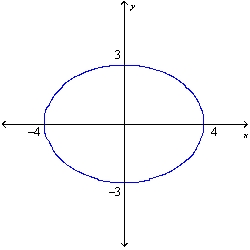
A)
B)
C)
D)


A)

B)

C)

D)


فتح الحزمة
افتح القفل للوصول البطاقات البالغ عددها 151 في هذه المجموعة.
فتح الحزمة
k this deck
43
Calculate  .
. 
A)
B)
C)
D)
E)None of these
 .
. 
A)

B)

C)

D)

E)None of these

فتح الحزمة
افتح القفل للوصول البطاقات البالغ عددها 151 في هذه المجموعة.
فتح الحزمة
k this deck
44
A circle's radius is increasing. Find the rate of change of the area of the circle with respect to the radius r when 


فتح الحزمة
افتح القفل للوصول البطاقات البالغ عددها 151 في هذه المجموعة.
فتح الحزمة
k this deck
45
Suppose the daily total cost (in dollars) of manufacturing x televisions is  What is the marginal cost when x = 600? What is the actual cost incurred in manufacturing the 601st television?
What is the marginal cost when x = 600? What is the actual cost incurred in manufacturing the 601st television?
A)$348.00, $348.58
B)$186.67, $186.94
C)$348.00, $348.46
D)$186.67, $186.98
 What is the marginal cost when x = 600? What is the actual cost incurred in manufacturing the 601st television?
What is the marginal cost when x = 600? What is the actual cost incurred in manufacturing the 601st television?A)$348.00, $348.58
B)$186.67, $186.94
C)$348.00, $348.46
D)$186.67, $186.98

فتح الحزمة
افتح القفل للوصول البطاقات البالغ عددها 151 في هذه المجموعة.
فتح الحزمة
k this deck
46
A spherical balloon is being inflated. Find the rate of increase of the surface area  with respect to the radius r when r =
with respect to the radius r when r =  ft.
ft.
 with respect to the radius r when r =
with respect to the radius r when r =  ft.
ft.
فتح الحزمة
افتح القفل للوصول البطاقات البالغ عددها 151 في هذه المجموعة.
فتح الحزمة
k this deck
47
Refer to the law of laminar flow. Consider a blood vessel with radius 0.01 cm, length 3 cm, pressure difference  and viscosity =0.028.
and viscosity =0.028.
Find the velocity of the blood at radius r =
 and viscosity =0.028.
and viscosity =0.028.Find the velocity of the blood at radius r =


فتح الحزمة
افتح القفل للوصول البطاقات البالغ عددها 151 في هذه المجموعة.
فتح الحزمة
k this deck
48
If 
A)
B)
C)
D)
E)None of these

A)

B)

C)

D)

E)None of these

فتح الحزمة
افتح القفل للوصول البطاقات البالغ عددها 151 في هذه المجموعة.
فتح الحزمة
k this deck
49
Newton's Law of Gravitation says that the magnitude F of the force exerted by a body of mass m on a body of mass M is  .
.
Find .
.
 .
.Find
 .
.
فتح الحزمة
افتح القفل للوصول البطاقات البالغ عددها 151 في هذه المجموعة.
فتح الحزمة
k this deck
50
The position function of a particle is given by  When does the particle reach a velocity of 22 m/s?
When does the particle reach a velocity of 22 m/s?
 When does the particle reach a velocity of 22 m/s?
When does the particle reach a velocity of 22 m/s?
فتح الحزمة
افتح القفل للوصول البطاقات البالغ عددها 151 في هذه المجموعة.
فتح الحزمة
k this deck
51
Find  in terms of x and y.
in terms of x and y. 
A)
B)
C)
D)
 in terms of x and y.
in terms of x and y. 
A)

B)

C)

D)


فتح الحزمة
افتح القفل للوصول البطاقات البالغ عددها 151 في هذه المجموعة.
فتح الحزمة
k this deck
52
Calculate  .
. 
 .
. 

فتح الحزمة
افتح القفل للوصول البطاقات البالغ عددها 151 في هذه المجموعة.
فتح الحزمة
k this deck
53
Find  by implicit differentiation.
by implicit differentiation. 
 by implicit differentiation.
by implicit differentiation. 

فتح الحزمة
افتح القفل للوصول البطاقات البالغ عددها 151 في هذه المجموعة.
فتح الحزمة
k this deck
54
The mass of part of a wire is  kilograms, where x is measured in meters from one end of the wire. Find the linear density of the wire when x =16m .
kilograms, where x is measured in meters from one end of the wire. Find the linear density of the wire when x =16m .
A)
B)
C)
D)
E)
 kilograms, where x is measured in meters from one end of the wire. Find the linear density of the wire when x =16m .
kilograms, where x is measured in meters from one end of the wire. Find the linear density of the wire when x =16m .A)

B)

C)

D)

E)


فتح الحزمة
افتح القفل للوصول البطاقات البالغ عددها 151 في هذه المجموعة.
فتح الحزمة
k this deck
55
Use implicit differentiation to find an equation of the tangent line to the curve at the given point. 


فتح الحزمة
افتح القفل للوصول البطاقات البالغ عددها 151 في هذه المجموعة.
فتح الحزمة
k this deck
56
Find the average rate of change of the area of a circle with respect to its radius r as r changes from  to
to  .
.
A)
B)
C)
D)
E)
 to
to  .
.A)

B)

C)

D)

E)


فتح الحزمة
افتح القفل للوصول البطاقات البالغ عددها 151 في هذه المجموعة.
فتح الحزمة
k this deck
57
If a tank holds 5000 gallons of water, and that water can drain from the tank in 40 minutes, then Torricelli's Law gives the volume V of water remaining in the tank after t minutes as  .
.
Find the rate at which water is draining from the tank after 6 minutes.
 .
.Find the rate at which water is draining from the tank after 6 minutes.

فتح الحزمة
افتح القفل للوصول البطاقات البالغ عددها 151 في هذه المجموعة.
فتح الحزمة
k this deck
58
Use implicit differentiation to find an equation of the tangent line to the curve at the indicated point. y = sin xy7; 
A)y = x
B)y = 1
C)y = 7x + 1
D)x =

A)y = x
B)y = 1
C)y = 7x + 1
D)x =


فتح الحزمة
افتح القفل للوصول البطاقات البالغ عددها 151 في هذه المجموعة.
فتح الحزمة
k this deck
59
Find  by implicit differentiation.
by implicit differentiation. 
 by implicit differentiation.
by implicit differentiation. 

فتح الحزمة
افتح القفل للوصول البطاقات البالغ عددها 151 في هذه المجموعة.
فتح الحزمة
k this deck
60
Find  by implicit differentiation.
by implicit differentiation. 
A)
B)
C)
D)
 by implicit differentiation.
by implicit differentiation. 
A)

B)

C)

D)


فتح الحزمة
افتح القفل للوصول البطاقات البالغ عددها 151 في هذه المجموعة.
فتح الحزمة
k this deck
61
Find the second derivative of the function. 
A)
B)
C)
D)

A)

B)

C)

D)


فتح الحزمة
افتح القفل للوصول البطاقات البالغ عددها 151 في هذه المجموعة.
فتح الحزمة
k this deck
62
Find the derivative of the function. 
A)
B)
C)
D)
E)

A)

B)

C)

D)

E)


فتح الحزمة
افتح القفل للوصول البطاقات البالغ عددها 151 في هذه المجموعة.
فتح الحزمة
k this deck
63
Use the table to estimate the value of  , where
, where  and
and  .
.  10
10
10.1
10.2
10.3
10.4
10.5
10.6 4.5
4.5  5.6
5.6
4.3
2.5
9.9
7.8 6.5
6.5
5.9
4.7
4.2
5.4 6.3
6.3
 , where
, where  and
and  .
.  10
1010.1
10.2
10.3
10.4
10.5
10.6
 4.5
4.5  5.6
5.64.3
2.5
9.9
7.8
 6.5
6.55.9
4.7
4.2
5.4
 6.3
6.3
فتح الحزمة
افتح القفل للوصول البطاقات البالغ عددها 151 في هذه المجموعة.
فتح الحزمة
k this deck
64
Calculate  .
. 
 .
. 

فتح الحزمة
افتح القفل للوصول البطاقات البالغ عددها 151 في هذه المجموعة.
فتح الحزمة
k this deck
65
Find the derivative of the function. 
A)
B)
C)
D)

A)

B)

C)

D)


فتح الحزمة
افتح القفل للوصول البطاقات البالغ عددها 151 في هذه المجموعة.
فتح الحزمة
k this deck
66
If  , find
, find  and
and  .
.
A)
B)
C)
D)
E)
 , find
, find  and
and  .
. A)

B)

C)

D)

E)


فتح الحزمة
افتح القفل للوصول البطاقات البالغ عددها 151 في هذه المجموعة.
فتح الحزمة
k this deck
67
Find the derivative of the function. g(t) = tan(cos 2t)
A)
B)
C)
D)
A)

B)

C)

D)


فتح الحزمة
افتح القفل للوصول البطاقات البالغ عددها 151 في هذه المجموعة.
فتح الحزمة
k this deck
68
Two curves are said to be orthogonal if their tangent lines are perpendicular at each point of intersection of the curves. Show that the curves of the given equations are orthogonal.
y - x =
x =  x =
x =  cos y
cos y 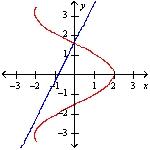
y -
 x =
x =  x =
x =  cos y
cos y 

فتح الحزمة
افتح القفل للوصول البطاقات البالغ عددها 151 في هذه المجموعة.
فتح الحزمة
k this deck
69
Find the rate of change of y with respect to x at the given values of x and y.  ; x = 3, y = -5
; x = 3, y = -5
 ; x = 3, y = -5
; x = 3, y = -5
فتح الحزمة
افتح القفل للوصول البطاقات البالغ عددها 151 في هذه المجموعة.
فتح الحزمة
k this deck
70
Find an equation of the tangent line to the given curve at the indicated point. 
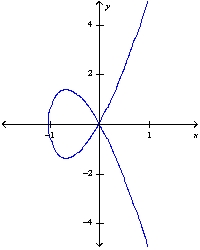



فتح الحزمة
افتح القفل للوصول البطاقات البالغ عددها 151 في هذه المجموعة.
فتح الحزمة
k this deck
71
Differentiate. 


فتح الحزمة
افتح القفل للوصول البطاقات البالغ عددها 151 في هذه المجموعة.
فتح الحزمة
k this deck
72
Find the derivative of the function.



فتح الحزمة
افتح القفل للوصول البطاقات البالغ عددها 151 في هذه المجموعة.
فتح الحزمة
k this deck
73
Find the derivative of the following function and calculate it for x =  to the nearest tenth.
to the nearest tenth. 
A)0.2
B)
C)1.1
D)0.3
E)0.1
 to the nearest tenth.
to the nearest tenth. 
A)0.2
B)

C)1.1
D)0.3
E)0.1

فتح الحزمة
افتح القفل للوصول البطاقات البالغ عددها 151 في هذه المجموعة.
فتح الحزمة
k this deck
74
Find the derivative of the function. 
A)
B)
C)
D)
E)

A)

B)

C)

D)

E)


فتح الحزمة
افتح القفل للوصول البطاقات البالغ عددها 151 في هذه المجموعة.
فتح الحزمة
k this deck
75
The curve with the equation  is called an astroid. Find an equation of the tangent to the curve at the point (
is called an astroid. Find an equation of the tangent to the curve at the point (  , 1).
, 1). 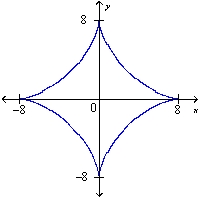
 is called an astroid. Find an equation of the tangent to the curve at the point (
is called an astroid. Find an equation of the tangent to the curve at the point (  , 1).
, 1). 

فتح الحزمة
افتح القفل للوصول البطاقات البالغ عددها 151 في هذه المجموعة.
فتح الحزمة
k this deck
76
Find the equation of the tangent to the curve at the given point. 


فتح الحزمة
افتح القفل للوصول البطاقات البالغ عددها 151 في هذه المجموعة.
فتح الحزمة
k this deck
77
If u is a differentiable function of x and f (x) = |u| then  . Use this to find the derivative of the following function.
. Use this to find the derivative of the following function.
F (x) = |x2 - 4|
A)
B)
C)
D)
 . Use this to find the derivative of the following function.
. Use this to find the derivative of the following function.F (x) = |x2 - 4|
A)

B)

C)

D)


فتح الحزمة
افتح القفل للوصول البطاقات البالغ عددها 151 في هذه المجموعة.
فتح الحزمة
k this deck
78
Find 


فتح الحزمة
افتح القفل للوصول البطاقات البالغ عددها 151 في هذه المجموعة.
فتح الحزمة
k this deck
79
If  , find
, find  .
.
A)
B)
C)
D)
E)
 , find
, find  .
.A)

B)

C)

D)

E)


فتح الحزمة
افتح القفل للوصول البطاقات البالغ عددها 151 في هذه المجموعة.
فتح الحزمة
k this deck
80
Find the derivative of the function. 
A)
B)
C)
D)

A)

B)

C)

D)


فتح الحزمة
افتح القفل للوصول البطاقات البالغ عددها 151 في هذه المجموعة.
فتح الحزمة
k this deck








